Similar questions are:
More than one DbContext was found - answers mainly discuss syntax
Unable to create an object of type 'ApplicationDbContext'. For the different patterns supported at design time - nothing here
After a year away from this project I decided to change some database fields. So I have now remodelled the database schema for my ASP .Net Entity Frameworks (with Identity) project. My changes have remodelled my data table NOT the identity part of my project.
Get-Package
Id Versions ProjectName
-- -------- -----------
bootstrap {5.1.0} rollbase
Microsoft.EntityFrameworkCore.Sq... {5.0.12} rollbase
Microsoft.EntityFrameworkCore.De... {5.0.11} rollbase
Microsoft.AspNetCore.Diagnostics... {5.0.9} rollbase
Microsoft.AspNetCore.Identity.En... {5.0.9} rollbase
Microsoft.EntityFrameworkCore.Tools {5.0.11} rollbase
Microsoft.VisualStudio.Web.CodeG... {5.0.2} rollbase
Microsoft.AspNetCore.Identity.UI {5.0.12} rollbase
I decided to remove my migrations folder, to begin again, because I already had a lot of migrations. I checked on what database contexts I have:
PM> Get-DbContext
Build started...
Build succeeded.
The Entity Framework tools version '5.0.11' is older than that of the runtime '5.0.12'. Update the tools for the latest features and bug fixes.
ApplicationDbContext
rollbase.Areas.Identity.Data.ApplicationDbContext:
For:
PM> Add-Migration InitialCreate -Verbose
I get this familiar error:
More than one DbContext was found. Specify which one to use. etc
Using the output of Get-DbContext I try:
PM> Add-Migration InitialCreate -Context ApplicationDbContext
Even though I specify the context I still get the 'More than one DbContext was found'
Using:
PM> Add-Migration InitialCreate -Context IdentityDbContext -Verbose
I get: No DbContext named 'IdentityDbContext' was found.
Recapping on what I know about my database context:
The database context is registered with the Dependency Injection container in the ConfigureServices method in Startup.cs file:
services.AddDbContext<ApplicationDbContext>(options =>
options.UseSqlServer(
Configuration.GetConnectionString("DefaultConnection")));
Here. Just like the output from Get-DbContext It is clear that the DbContext to be used is ApplicationDbContext
However. After reading This DbContext Lifetime, Configuration, and Initialization the following caught my attention:
"The ApplicationDbContext class must expose a public constructor with a DbContextOptions<ApplicationDbContext> parameter. This is how context configuration from AddDbContext is passed to the DbContext. For example:"
public class ApplicationDbContext : DbContext
{
public ApplicationDbContext(DbContextOptions<ApplicationDbContext> options)
: base(options)
{
}
}
But my ApplicationDbContext class looks like this:
public class ApplicationDbContext : IdentityDbContext
{
public ApplicationDbContext(DbContextOptions<ApplicationDbContext> options)
: base(options)
{
}
So my ApplicationDbContext inherits from IdentityDbContext instead of DbContext?
I found this old stackoverflow post ASP.NET Identity DbContext confusion which discusses the same problem. I must confess I got lost reading the proposals for dealing with this issue. Partly due to the fact that I have a solution that I've had running fine. Deployed to Azure etc.
The last migration shows on GitHub repo like this:
namespace rollbase.Data.Migrations
{
[DbContext(typeof(ApplicationDbContext))]
[Migration("20211015203803_UpdateIncludeEntryTable")]
At this point I'm confused. I had previously done around 10 migrations on this project. I can still log in as a user. So why can't I choose a database context and migrate my remodeling to localdb?
Any suggestions would be appreciated.
